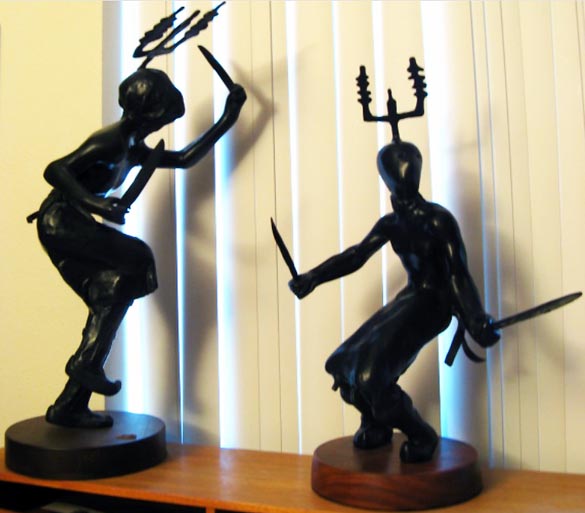 ‘Devil Dancers’ bronze sculptures by Michael Naranjo from the collection of Robert Wells. Courtesy/LAMOA
‘Devil Dancers’ bronze sculptures by Michael Naranjo from the collection of Robert Wells. Courtesy/LAMOA
The Los Alamos Museum of Art would like to introduce some of our fabulous collections including “Devil Dancers” bronze sculptures by Santa Clara Pueblo artist Michael Naranjo from the collection of Robert Wells.
Touch is the tool that Naranjo uses to create his sculptures. Their smooth rounded forms invite one to feel the strength and contours of their poses. His ability is all the more impressive when you learn that he lost the use of one hand and his eyesight to a grenade in the 1960’s in the Viet Nam War. Undeterred, he became a world renowned sculptor.
“Sculpture is what I wanted to do. Somehow it lends itself to touch. So it worked out, even with one hand and no eyes, I’m fortunate that I’m doing what I’ve always wanted to do … I wouldn’t trade my life for anything. I like my shoes….”
Naranjo is the son of Santa Clara potter Rose Naranjo, the Uncle of sculptor Roxanne Swentzell and the brother of Jody Folwell and Rina Swentzell who also are potters. The feel of clay was always in Naranjo’s life and carries through in his bronzes.
“I think we’re influenced from early on and that art lives within everyone but some people act on the impulse and begin to create,” he said.
Naranjo’s disability did not hinder him in pursuing his career or his curiosity. He was the artist in residence at Verkamps Visiter Center at the Grand Canyon.
“They let me look at their archives. I got to touch 4,000 year old sandals and cloth and an ancient sloth,” he said.
In 1983, Naranjo was granted a Papal audience, and with a letter of introduction in hand, he was welcomed in Italian Museums. In 1986 at the Galleria dell’ Accademia in Florence, he was allowed to climb scaffolding to touch Michaelangelo’s “David.”
Naranjo’s bronzes have a traditional matte black patina – the color he sees – and they are often described as imparting a sense of serenity.
“My movements are slow because if I move fast, I knock things over,” he said. “There’s a gentleness to my life that probably carries over to my pieces.”
Apache Devil Dancers are not deities but more like men with special abilities, one of which is the ability to be invisible. Devil Dancers would show up after a dance had started. No one could see them but they were responsible for a lot of racket. To honor the Devil Dancers, some Apache men would dress up like Devil Dancers, usually with bells sewn on their sleeves and leggings, and after the dances started they would run out from places of hiding creating a stir.
The Los Alamos Museum of Art is a non-profit 501 (c)(3) tax exempt organization in the process of securing adequate space for its collections. Visit www.lamoa.us.

